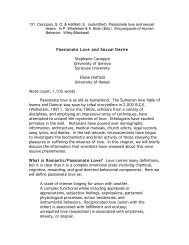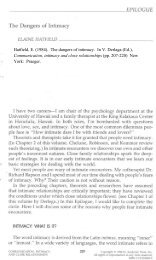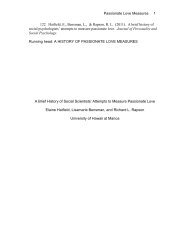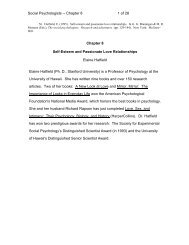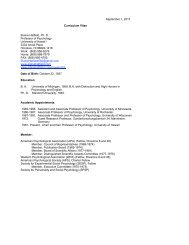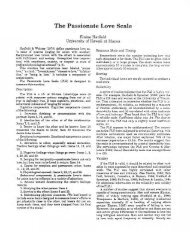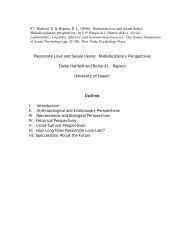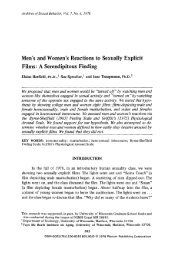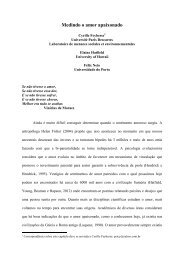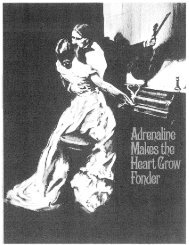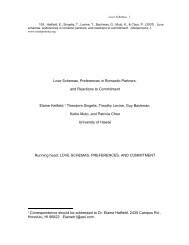Passionate Love and Sexual Desire - Elaine Hatfield
Passionate Love and Sexual Desire - Elaine Hatfield
Passionate Love and Sexual Desire - Elaine Hatfield
Create successful ePaper yourself
Turn your PDF publications into a flip-book with our unique Google optimized e-Paper software.
78. <strong>Hatfield</strong>, E., Rapson, R. L.. & Martel, L.D. (in press). “<strong>Passionate</strong> <strong>Love</strong>.” InS. Kitayama & D. Cohen (Eds.) H<strong>and</strong>book of Cultural Psychology.New York:Guilford Press.<strong>Passionate</strong> <strong>Love</strong> <strong>and</strong> <strong>Sexual</strong> <strong>Desire</strong><strong>Elaine</strong> <strong>Hatfield</strong>, Richard L. Rapson, <strong>and</strong> Lise D. MartelUniversity of Hawai‘iI. Introduction<strong>Passionate</strong> love is a universal emotion, experienced by almost all people, in allhistorical eras, <strong>and</strong> in all the world’s cultures (see Fischer, Shaver, & Carnochan, 1990;Shaver, Morgan, & Wu, 1996). Yet, despite its universality, culture has been found tohave a profound impact on people’s definitions of love <strong>and</strong> on the way they think, feel,<strong>and</strong> behave in romantic settings. Cross-cultural studies provide a glimpse into thecomplex world of emotion <strong>and</strong> allow us to gain an underst<strong>and</strong>ing of the extent to whichpeople’s emotional lives are written in their cultural <strong>and</strong> personal histories as well as“writ in their genes” <strong>and</strong> evolutionary history <strong>and</strong> in the interaction of the two (Tooby &Cosmides, 1992).A. Defining <strong>Love</strong>II. <strong>Passionate</strong> <strong>and</strong> Companionate <strong>Love</strong>Poets, novelists, <strong>and</strong> social commentators have proposed numerousdefinitions of love. Ahdat Soueif (1999), an Arab novelist, once poetically describedthe multitude of meanings that “love” possesses in Arabic:“Hubb” is love, “ishq” is love that entwines two people together, “shaghaf”is love that nests in the chambers of the heart, “hayam” is love that w<strong>and</strong>ersthe earth, “teeh” is love in which you lose yourself, “walah” is love thatcarries sorrow within it, “sababah” is love that exudes from your pores,“hawa” is love that shares its name with “air” <strong>and</strong> with “falling”, “gharm”is love that is willing to pay the price. (pp. 386-387)
2Cultural theorists have long been interested in the impact of culture on themeaning that young men <strong>and</strong> women ascribe to “love.” Scholars usually distinguishbetween two kinds of love: “passionate love” <strong>and</strong> “companionate love.” (<strong>Hatfield</strong> &Rapson, 1993)<strong>Passionate</strong> love (sometimes called “obsessive love,” “infatuation,”“lovesickness,” or “being-in-love”) is a powerful emotional state. It has been defined as:A state of intense longing for union with another. <strong>Passionate</strong> love is acomplex functional whole including appraisals or appreciations, subjectivefeelings, expressions, patterned physiological processes, action tendencies,<strong>and</strong> instrumental behaviors. Reciprocated love (union with the other) isassociated with fulfillment <strong>and</strong> ecstasy. Unrequited love (separation) isassociated with feelings of emptiness, anxiety, <strong>and</strong> despair. (<strong>Hatfield</strong> &Rapson, 1993, p. 5)People in all cultures recognize the power of passionate love. In South IndianTamil families, for example, a person who falls head-over-heels in love with another issaid to be suffering from mayakkam—dizziness, confusion, intoxication, <strong>and</strong> delusion.The wild hopes <strong>and</strong> despairs of love are thought to “mix you up.” (Trawick, 1990)The <strong>Passionate</strong> <strong>Love</strong> Scale was designed to tap into the cognitive, emotional, <strong>and</strong>behavioral indicants of such longings. (<strong>Hatfield</strong> & Sprecher, 1986) The PLS has beenfound to be a useful measure of passionate love with men <strong>and</strong> women of all ages, in avariety of cultures, <strong>and</strong> has been found to correlate well with certain well-defined patterns
3of neural activation (see Bartels & Zeki, 2000, 2004; Doherty, <strong>Hatfield</strong>, Thompson, &Choo, 1994; Fisher, 2003; L<strong>and</strong>is & O’Shea, 2000.)Companionate love is a far less intense emotion. It combines feelings ofattachment, commitment, <strong>and</strong> intimacy (<strong>Hatfield</strong> & Rapson, 1993.) It has been definedas:The affection <strong>and</strong> tenderness we feel for those with whom our lives aredeeply entwined. (<strong>Hatfield</strong> & Rapson, 1993, p. 9)Psychologists have used a variety of scales to measure companionate love. SinceSternberg (1988) postulated that companionate relationships require both commitment<strong>and</strong> intimacy, many researchers have assessed such love by measuring those twocomponents.Other Definitions of <strong>Love</strong>: Scientists have proposed a variety of definitions <strong>and</strong>typologies of love (see Hendrick & Hendrick, 1989; Shaver & Hazan, 1988; Sternberg,1988.) According to Sternberg (1988), for example, types of love are determined byvarious combinations of passion, intimacy, <strong>and</strong> commitment. Possible combinationsresult in Romantic <strong>Love</strong>, Infatuation, Companionate <strong>Love</strong>, Liking, Fatuous <strong>Love</strong>, Empty<strong>Love</strong>, <strong>and</strong> Consummate <strong>Love</strong>.In this chapter we will focus on passionate love; we will touch upon othervarieties of love only briefly, if at all.III. Theoretical Underst<strong>and</strong>ings of <strong>Passionate</strong> <strong>Love</strong>A. Anthropological Perspectives on <strong>Passionate</strong> <strong>Love</strong><strong>Passionate</strong> love is as old as humankind. The Sumerian love fable of Inanna <strong>and</strong>Dumuzi, for example, was spun by tribal storytellers in 2,000 BCE. (Wolkstein, 1991)
4Today, most anthropologists argue that passionate love is a universal experience,transcending culture <strong>and</strong> time (Buss, 1994; <strong>Hatfield</strong> & Rapson, 1996; Jankowiak, 1995;Tooby & Cosmides, 1992).Jankowiak <strong>and</strong> Fischer (1992) drew a sharp distinction between “romanticpassion” <strong>and</strong> “simple lust.” They proposed that both passion <strong>and</strong> lust are universalfeelings. Drawing on a sampling of tribal societies from the St<strong>and</strong>ard Cross-CulturalSample, they found that in almost all of these far flung societies, young lovers talkedabout passionate love, recounted tales of love, sang love songs, <strong>and</strong> spoke of the longings<strong>and</strong> anguish of infatuation. When passionate affections clashed with parents’ or elders’wishes, young couples often eloped.Social anthropologists have explored folk conceptions of love in such diversecultures as The People’s Republic of China, Indonesia, Turkey, Nigeria, Trinidad,Morocco, <strong>and</strong> the Fulbe of North Cameroun, the Mangrove (an aboriginal Australiancommunity), the Mangaia in the Cook Isl<strong>and</strong>s, Palau in Micronesia, <strong>and</strong> the Taita ofKenya (see Jankowiak, 1995, for a review of this research.) In all these studies, people’sconceptions of passionate love appear to be surprisingly similar.Anthropologists have also been interested in the kinds of societies in which ourprimate ancestors lived. Sommer (1993), for example, asked a challenging question: Didour ancient Homo sapiens ancestors live in monogamous, polygamous, poly<strong>and</strong>rous, orpolygyn<strong>and</strong>rous communities? (In monogamy, a man <strong>and</strong> woman marry—usually for alifetime. In polygamy, one man may possess many wives; in poly<strong>and</strong>ry, one woman maytake several husb<strong>and</strong>s. In polygyn<strong>and</strong>ry, or “promiscuous” mating, men <strong>and</strong> women maymate at will.)
5After observing many kinds of primates, Sommer discovered that it is easy topredict what sort of sexual mating arrangements a primate species will adopt. All heneeded to know were four facts: (1) in that species, who is bigger—the males or thefemales? (2) how much do the males’ testes weigh? (3) do females have sexualswellings (which signal sexual receptivity <strong>and</strong> fertility)? <strong>and</strong> (4) how long does sexualintercourse last? (The scientists found, for example, that in monogamous species suchas gibbons, males <strong>and</strong> females are generally about the same size. In polygynousspecies such as orangutans (where successful males must physically dominate theirrivals), males are much larger than their mates.When Sommer classified Homo sapiens on these four characteristics, hiscalculations led him to conclude that although our human forebears may have beenmonogamous, the odds are that they were polygynous. 1There is no chance that theywere either poly<strong>and</strong>rous or polygyn<strong>and</strong>rous.What about our more immediate ancestors? How did they live? On the basis ofher calculations, Fisher (1989) concluded that throughout the world, although (intheory) most societies are polygynous, in fact, the overwhelming majority of marriedmen <strong>and</strong> women are actually in monogamous marriages. Fisher studied the maritalarrangements of the 853 societies sampled in the Ethnographic Atlas. (The Atlascontains anthropological information on more than 1,000 representative pre-industrialsocieties throughout the world.) She found that although almost all societies (84%)1 Arguing that in prehistory people might have been monogamous is the fact that today men<strong>and</strong> women are fairly similar in size. Arguing (more strongly) that our ancestors werepolygamous are the facts that: (1) men are generally taller <strong>and</strong> stronger than are women. (2)Since selection is based on physical strength <strong>and</strong> body mass, not sperm competition, men'stestes are fairly small. (3) women do not possess sexual swellings. (4) <strong>Sexual</strong> intercoursecan last fairly long, since there are not many rivals competing for access.
6permitted polygyny, men rarely exercised this option. (Only about 10% of menpossessed more than one wife. Most possessed just one wife. A few were unmarried.)In l6% of societies, monogamy was prescribed. Poly<strong>and</strong>ry was extremely rare. Only0.5% of societies permitted poly<strong>and</strong>ry. In recent years, however, theorists such asWilson <strong>and</strong> Daly (1992) have observed that in humankinds’ long evolutionary history,although in theory men <strong>and</strong> women are “supposed” to be faithful to one partner, therewere many situations in which it was to a man or woman’s benefit to break the rules<strong>and</strong> “mate poach.” Thus, humans are likely to possess a variety of cognitive structuresdesigned to deal with a multitude of contingencies (See Barkow, Cosmides &, Tooby,1992, Hrdy, 1999, <strong>and</strong> Wilson & Daly, 1992; for a discussion of the factors that made<strong>and</strong> make it advantageous (or costly) for men <strong>and</strong> women to seek a variety of sexualpartners.)B. Genetic <strong>and</strong> Biological Perspectives on <strong>Love</strong>Recently, social psychologists, neuro-scientists, <strong>and</strong> physiologists have begun toexplore the links between love, sexual desire, <strong>and</strong> sexual behavior.The first neuroscientists to study passionate love using fMRI techniques to wereBirbaumer <strong>and</strong> his colleagues (1993). They concluded passionate love was “mentalchaos.” More recently, Bartels <strong>and</strong> Zeki (2000, 2004) studied the neural bases ofpassionate love using fMRI (brain imaging) techniques. They interviewed young men<strong>and</strong> women from 11 countries <strong>and</strong> several ethnic groups who claimed to be “truly,deeply, <strong>and</strong> madly” in love <strong>and</strong> who scored high on the <strong>Passionate</strong> <strong>Love</strong> Scale (PLS).The authors concluded that passionate love leads to a suppression of activity in theareas of the brain controlling critical thought; they argue that once we get close to
7someone, there is less need to assess their character <strong>and</strong> personality in a negative way.Passion also produced increased activity in the brain areas associated with euphoria <strong>and</strong>reward, <strong>and</strong> decreased levels of activity in the areas associated with distress <strong>and</strong>depression. Activity seemed to be restricted to foci in the medial insula <strong>and</strong> the anteriorcingulated cortex <strong>and</strong>, subcortically, in the caudate nucleus, <strong>and</strong> the putamen, allbilaterally. Deactivations were observed in the posterior cingulated gyrus <strong>and</strong> in theamygdala <strong>and</strong> were right-lateralized in the prefrontal, parietal, <strong>and</strong> middle temporalcortices.The conclusion?We conclude that human attachment employs a push-pull mechanism thatovercomes social distance by deactivating networks used for criticalsocial assessment <strong>and</strong> negative emotions, while it bonds individualsthrough the involvement of the reward circuitry, explaining the power oflove to motivate <strong>and</strong> exhilarate (Bartels & Zeki, 2004, p. 1155).The authors also found passionate love <strong>and</strong> sexual arousal to be tightly linked.Other psychologists who have studied the links between passionate love <strong>and</strong>sexual desire (using fMRI techniques) have found similar results. Fisher <strong>and</strong> hercolleagues (2003, 2004), for example, investigated the brain chemistry of men <strong>and</strong>women passionately in love (again using the PLS scale) <strong>and</strong> found that passionate lovemarkedly increased sexual motivation.In parallel with this research, a number of social psychologists, neurobiologists,<strong>and</strong> physiologists have begun to explore the neural <strong>and</strong> chemical substrates of passionate
8love, sexual desire, <strong>and</strong> sexual mating (Carter, 1998; Komisaruk, 1998; Marazziti et al.,1999; Marazziti & Canale, 2004.)Scientists interested in the chemistry of passionate love have found that a varietyof neurochemicals shape passionate love <strong>and</strong> sexual desire. According to Fisher (2004)for example, romantic love is associated with the natural stimulant dopamine <strong>and</strong> perhapsnorepinephrine <strong>and</strong> serotonin. Lust is associated primarily with the hormone testosteronein both men <strong>and</strong> women. (Estrogen may decrease desire.) Attachment is producedprimarily by the hormones oxytocin <strong>and</strong> vasopressin (see also Hyde, 2005; Marazziti &Canale, 2004; Regan & Berscheid, 1999.)Psychologists may differ on whether romantic <strong>and</strong> passionate love are or are notemotions (Aron, et al., in press; Shaver, Morgan, & Wu, S., 1996) <strong>and</strong> whether passionatelove, sexual desire, <strong>and</strong> sexual motivation are closely related constructs (bothneurobiologically or physiologically) or very different in their nature (Aron, et al., inpress; Diamond, 2004; <strong>Hatfield</strong> & Rapson, 1987). Nonetheless, this path-breakingresearch has the potential to answer age-old questions as to the nature of culture, love,<strong>and</strong> human sexuality.In spite of the fact that anthropologists, neurobiologists, <strong>and</strong> physioloigistsconsider passionate love to be a pan-human characteristic—an emotion thought to exist inall cultures <strong>and</strong> in all historical eras—culture has been found to exert a profound impacton people’s romantic <strong>and</strong> sexual attitudes, emotions, <strong>and</strong> behaviors.C. Historical Perspectives on <strong>Love</strong>Any time scholars begin talking glibly about “cultural universals,” historians tendto react with skepticism. Historians prefer to emphasize the multiplicity, variability, <strong>and</strong>
9mutability of human behavior. They shy away from all single-cause explanations forhow cultures <strong>and</strong> individuals work, <strong>and</strong> they revel in complexity, movement, <strong>and</strong> change.Not surprising then, when it comes to romance, historians invariably note thatpassionate attitudes <strong>and</strong> behaviors have varied dramatically from one culture to anotheror from one temporal period to the next. Some typical examples: The sage Vatsayanaadvised men <strong>and</strong> women to marry for love; the Medieval church condemned such sinfulindulgence. The early Egyptians practiced birth control <strong>and</strong> some Polynesians practicedinfanticide; the Classical Greeks rewarded couples who were willing to conceive. TheEskimos considered it hospitable to share their wives with visitors; the Muslims jealousylocked their wives <strong>and</strong> concubines away in harems. Sumerian <strong>and</strong> Babylonian templeswere staffed by priests, priestesses, <strong>and</strong> sacred prostitutes; the ancient Hebrews stoned“godless” prostitutes. Hellenes idealized the pure sexual love between older men <strong>and</strong>young boys; the Aztecs punished homosexuality by tying men to logs, disembowelingthem, covering them with ash, <strong>and</strong> incinerating them. (Tannahill, 1980)Historians have also documented how profoundly a society’s attitudes towardlove, sex, <strong>and</strong> intimacy can alter over time. Consider China. China possesses an ancientculture. Its archeological record begins 5,000 years ago in the Hongshan (Red Mountain)dynasty. Its historical record begins 4,000 years ago in the Xia (or First Dynasty). Theoldest Chinese medical texts on love <strong>and</strong> sexuality date from 168 BCE.Traditionally, Chinese history is divided into three periods: the Formative Age(Prehistory-206 BCE), the Early Empire (206 BCE-960 CE), <strong>and</strong> the Later Empire (960-1911 CE). The Chinese historian Ruan (1991,) argued that during the first 4,000 years ofChinese history, attitudes toward passionate love <strong>and</strong> sexual desire were generally
10positive—although hardly uniform <strong>and</strong> unchanging during these epochs. Medical textsdating back to 168 BCE make it clear that the ancients assumed that love <strong>and</strong> sexualpleasure were two of the great joys of life. In the Late Empire (1,000 years ago), duringthe Sung dynasty, the Neo-Confucianists gained political <strong>and</strong> religious power, <strong>and</strong>Chinese attitudes began to alter, gradually becoming more <strong>and</strong> more negative <strong>and</strong>repressive concerning sex. Displays of love outside marriage were forbidden, <strong>and</strong> eroticart <strong>and</strong> literature were often burned.When the People’s Republic of China was established in 1949, Communistofficials imposed even tighter controls on love <strong>and</strong> “inappropriate” sexual activity. On avisit to Beijing, Money (1977) reported: “I came across a slogan: ‘Making love is amental disease that wastes time <strong>and</strong> energy.’”Gil (1992) noted:A puritanical, if not heavy-h<strong>and</strong>ed, sexual “primness” became firmlyestablished. . . This included a denial of romantic love, the affirmationof the absolute role of the collective over the individual as a basictenet toward which one should direct any affections. The Great LeapForward dem<strong>and</strong>ed, in Communist parlance, the “renunciation of theheart.” Party policy deliberately constructed an altruism whichsought (for every man <strong>and</strong> woman) hard work during the day, withoutbeing “deflected or confused” by love, sexual desire, or any strivingsfor private happiness (p. 571).Today, of course, in China as throughout much of the rest of the world, the windsof change are wafting. Young people—perhaps as a consequence of globalization (as
11evidenced in the availability of international cinema, the Web, world travel, MTV)—are adopting more “liberal” or “worldly” views of passionate love, sexual desire,marriage for love (rather than arranged marriages,) <strong>and</strong> romantic <strong>and</strong> sexual diversity.In China, then, things appear to have come full circle.Historical research, then, reminds us that, throughout time, people have embracedvery different attitudes toward romantic <strong>and</strong> passionate love, have ascribed verydifferent meanings to “love,” have desired very different traits in romantic partners, <strong>and</strong>have differed markedly in whether such feelings were to be proclaimed to the world orhidden in the deepest recesses of the heart. In the real world, human sexual attitudes<strong>and</strong> behavior seem forever in flux.D. Culture <strong>and</strong> <strong>Passionate</strong> <strong>Love</strong>Americans are preoccupied with love—or so cross-cultural observers onceclaimed. In a famous quip, Linton (1936) once mocked Americans for their naïveidealization of romantic love <strong>and</strong> their assumption that romantic love was a prerequisiteto marriage:All societies recognize that there are occasional violent, emotionalattachments between persons of opposite sex, but our present Americanculture is practically the only one which has attempted to capitalize these,<strong>and</strong> make them the basis for marriage. . . . The hero of the modernAmerican movie is always a romantic lover, just as the hero of the oldArab epic is always an epileptic. A cynic may suspect that in any ordinarypopulation the percentage of individuals with a capacity for romantic love
12of the Hollywood type was about as large as that of persons able to throwgenuine epileptic fits. (p. 175)Throughout the world, a spate of commentators have echoed Linton’s claim thatthe idealization of passionate love is a peculiarly Western institution.A bit of background: The world’s cultures differ profoundly in the extent towhich they emphasize individualism or collectivism (although some cross-culturalresearchers would focus on related concepts: independence or interdependence,modernism or traditionalism, urbanism or ruralism, affluence or poverty).Individualistic cultures such as the United States, Britain, Australia, Canada, <strong>and</strong>the countries of Northern <strong>and</strong> Western Europe tend to focus on personal goals.Collectivist cultures such as China, many African <strong>and</strong> Latin American nations, Greece,southern Italy, <strong>and</strong> the Pacific Isl<strong>and</strong>s, on the other h<strong>and</strong>, press their members tosubordinate personal interests to those of the group (Markus & Kitayama, 1991; Tri<strong>and</strong>is,McCusker, & Hui, 1990). Tri<strong>and</strong>is <strong>and</strong> his colleagues (1990) point out that inindividualistic cultures, young people are allowed to “do their own thing;” in collectivistcultures, the group comes first.Hsu (1953 <strong>and</strong> 1985) <strong>and</strong> Doi (1963 <strong>and</strong> 1973) contend that passionate love is aWestern phenomenon, almost unknown in China <strong>and</strong> Japan . . . <strong>and</strong> so incompatible withAsian values <strong>and</strong> customs that it is unlikely ever to gain a foothold among young Asians.Hsu (1953) writes: “An American asks, ‘How does my heart feel?’ A Chinese asks,‘What will other people say?’” (p. 50). Hsu points out that the Chinese generally use theterm “love” to describe not a respectable, socially sanctioned relationship, but an illicitliaison between a man <strong>and</strong> a woman.
13Chu (1985; Chu & Ju, 1993), too, argues that although in America, romantic love<strong>and</strong> compatibility are of paramount importance in mate selection, in China such thingsmatter little. Traditionally, parents <strong>and</strong> go-betweens arranged young peoples’ marriages.Parents’ primary concern is not love <strong>and</strong> compatibility but men tang hu tui. Do thefamilies possess the same social status? Are they compatible? Will the marriage bringsome social or financial advantage to the two families?On the basis of such testimony, cross-cultural researchers proposed that romanticlove would be common only in modern, industrialized countries. It should be less valuedin traditional cultures with strong, extended family ties (Simmons, Vom Kolke, &Shimizu, 1986.) It should be more common in modern, industrialized countries than indeveloping countries (Goode, 1959; Rosenblatt, 1967.)In recent years, cultural researchers have begun to test these provocativehypotheses.IV. Recent Research on Culture <strong>and</strong> <strong>Passionate</strong> <strong>Love</strong>Recently, cultural researchers have begun to investigate the impact (if any) ofculture on people’s definitions of love, what they desire in romantic partners, theirlikelihood of falling in love, the intensity of their passion, <strong>and</strong> their willingness toacquiesce in arranged marriages versus insisting on marrying for love. From thispreliminary research, it appears that although the differences cultural theorists haveobserved do in fact exist, oft times, cultures turn out to be more similar than one mightexpect. Let us now turn to this research.A. The Meaning of <strong>Passionate</strong> <strong>Love</strong>
14Recently, Shaver, Wu, <strong>and</strong> Schwartz (1991) interviewed young people inAmerica, Italy, <strong>and</strong> the People’s Republic of China about their emotional experiences.They found that Americans <strong>and</strong> Italians tended to equate love with happiness <strong>and</strong> toassume that both passionate <strong>and</strong> companionate love were intensely positive experiences.Students in Beijing, China, possessed a darker view of love. In the Chinese language,there are few “happy-love” words; love is associated with sadness. Not surprisingly,then, the Chinese men <strong>and</strong> women interviewed by Shaver <strong>and</strong> his colleagues tended toassociate passionate love with such ideographic words as infatuation, unrequited love,nostalgia, <strong>and</strong> sorrow love.Other cultural researchers agree that cultural values may, indeed, have a profoundimpact on the subtle shadings of meaning assigned to the construct of “love.” (Cohen, inpress; Kim & <strong>Hatfield</strong>, 2004; Kitayama, 2002; Luciano, E. M. C., 2003; Nisbet, 2003;Oyserman, Kemmelmeier, & Coon, 2002; Weaver & Ganong, 2004.)There is, however, considerable debate as to how ubiquitous <strong>and</strong> how importantsuch differences are. When social psychologists explored folk conceptions of love in asurprising variety of cultures—including the People’s Republic of China, Indonesia,Micronesia, Palau, <strong>and</strong> Turkey, —they found that people in the various culturespossessed surprisingly similar views of love <strong>and</strong> other “feelings of the heart” (seeFischer, Wang, Kennedy, & Cheng, 1998; Jankowiak, 1995; Kim <strong>and</strong> <strong>Hatfield</strong>, 2004;Shaver, Murdaya, & Fraley, 2001, for a review of this research.) In a typical study, forexample, Shaver, Murdaya, <strong>and</strong> Fraley (2001) argued that love <strong>and</strong> “sexual mating,reproduction, parenting, <strong>and</strong> maintaining relationships with kin <strong>and</strong> reciprocally altruisticrelationships with friends <strong>and</strong> neighbors are fundamental issues for humans (p. 219-220.)
15To test the notion that passionate <strong>and</strong> companionate love are cultural universals, theyconducted a “prototype” study to (1) determine what Indonesian (as compared toAmerican) men <strong>and</strong> women considered to be “basic” emotions, <strong>and</strong> (2) the meaning theyascribed to these emotions. Starting with 404 Indonesian “perasaan hati” (Emotionnames or “feelings of the heart,”) they asked people to sort the words into basic emotioncategories. As predicted, the Indonesians came up with the same five emotions thatAmericans consider to be basic: joy, love, sadness, fear, <strong>and</strong> anger. Furthermore, whenasked about the meanings of “love,” Indonesian men <strong>and</strong> women (like their Americancounterparts) were able to distinguish passionate love (“asmara,” orsexual/desire/arousal) from companionate love (“cinta” or affection/liking/fondness.)There were some differences in the American <strong>and</strong> Indonesian lexicons, however. Theauthors note:The Indonesian conception of love may place more emphasis on yearning<strong>and</strong> desire than the American conception, perhaps because the barriers toconsummation are more formidable in Indonesia, which is a moretraditional <strong>and</strong> mostly Muslin country. (p. 219.)Much more research needs to be done, of course, before scientists can state thisconclusion with any certainty.Perhaps love is, indeed, a cultural universal. Or perhaps the times they are ‘achanging. One impact of globalization (<strong>and</strong> the ubiquitous MTV, Hollywood <strong>and</strong>Bollywoood movies, chat rooms, <strong>and</strong> foreign travel) may be to ensure that when peoplespeak of “passionate love,” they are talking about much the same thing.B. What Men <strong>and</strong> Women <strong>Desire</strong> in Romantic Partners
16Since Darwin’s (1871) classic treatise on The Descent of Man, evolutionarytheorists have been interested in mate preferences. Many evolutionary psychologistscontend that there are cultural universals in what men <strong>and</strong> women desire in a mate.This contention is supported by a l<strong>and</strong>mark cross-cultural study conducted byBuss (1994). Buss asked over 10,000 men <strong>and</strong> women from 37 countries, to indicatewhat characteristics they sought in potential mates. These people came from a variety ofgeographic, cultural, political, ethnic, religious, racial, economic, <strong>and</strong> linguistic groups.Buss <strong>and</strong> his colleagues found that, overall, the single trait that men <strong>and</strong> women in allsocieties valued most was “mutual attraction-love.” After that, men <strong>and</strong> women carednext about finding someone who possessed a dependable character, emotional stability<strong>and</strong> maturity, <strong>and</strong> a pleasing disposition. Men tended to care more about the physicalappearance <strong>and</strong> youth of their partners than did women; women tended to be moreinsistent that their mates possess high status <strong>and</strong> the resources necessary to protectthemselves <strong>and</strong> their children than did men.Buss was interested in cultural <strong>and</strong> gender universals; nonetheless, he could nothelp but be struck by the powerful impact that culture had on other mentionedpreferences. In China, India, Indonesia, Iran, Israel (the Palestinian Arabs), <strong>and</strong> Taiwan,for example, young people were insistent that their mate should be “chaste.” In Finl<strong>and</strong>,France, Norway, the Netherl<strong>and</strong>s, Sweden, <strong>and</strong> West Germany, on the other h<strong>and</strong>, mostjudged chastity to be relatively unimportant. A few respondents even jotted notes in themargin of the questionnaire, indicating that, for them, chastity would be a disadvantage.In an alternative analysis of Buss’s (1994) data, Wallen (1989) attempted todetermine which was the most important—culture or gender—in shaping people’s mate
17preferences. He found that for some traits—such as good looks <strong>and</strong> financial prospects—gender had a great influence on preferences. (While gender accounted for 40%-45% ofthe variance, geographical origin accounted for only 8%-17% of the variance.) For othertraits—such as chastity, ambition, <strong>and</strong> preferred age—on the other h<strong>and</strong>, culture matteredmost. (In those instances, gender accounted for only 5%-16% of the variance, whereasgeographical origin accounted for 38%-59% of the variance.) Wallen concluded that, ingeneral, the cultural perspective may well be even more powerful than evolutionaryheritage in underst<strong>and</strong>ing mate selection.Cultural researchers provide additional evidence that in different cultural,national, <strong>and</strong> ethnic groups, people often desire very different things in romantic, sexual,or marital partners. <strong>Hatfield</strong> <strong>and</strong> Sprecher (1996), for example, studied three powerful,modern, <strong>and</strong> industrial societies—the United States, Russia, <strong>and</strong> Japan. Men <strong>and</strong> womenin Western, individualistic cultures (such as the United States <strong>and</strong> to some extent Russia)expected far more from their marriages than did couples in a collectivist culture (such asJapan).As we observed earlier, cultural theorists have predicted that cultural rules shouldexert a profound impact on the commonness of passionate feelings within a culture, howintensely passion is experienced, <strong>and</strong> how people attempt to deal with these tumultuousfeelings. Alas, the sparse existing data, provide only minimal support for this intriguing<strong>and</strong> plausible sounding hypothesis.C. The Likelihood of Being-in-<strong>Love</strong>Sprecher <strong>and</strong> her colleagues (1994) interviewed 1,667 men <strong>and</strong> women in theUnited States, Russia, <strong>and</strong> Japan. Based on notions of individualism versus collectivism,
18the authors predicted that American men <strong>and</strong> women would be most vulnerable to love,the Japanese the least likely to be “love besotted.” The authors found that they werewrong. In fact, 59% of American college students, 67% of Russians, <strong>and</strong> 53% of Japanesestudents said they were in love at the time of the interview. In all three cultures, men wereslightly less likely than were women to be in love. There was no evidence, however, thatindividualistic cultures breed young men <strong>and</strong> women who are more love-struck than docollectivist societies.Similarly, surveys of Mexican-American, Chinese-American, <strong>and</strong> Euro-Americanstudents have found that in a variety of ethnic groups, young men <strong>and</strong> women showsimilarly high rates of “being in love” at the present time. (Aron & Rodriguez, 1992;Doherty, <strong>Hatfield</strong>, Thompson, & Choo, 1994).D. The Intensity of <strong>Passionate</strong> <strong>Love</strong>Cultures also seem to share more similarities than differences in the intensity ofpassionate love they experience. In one study, <strong>Hatfield</strong> <strong>and</strong> Rapson (1996) asked men <strong>and</strong>women of European, Filipino, <strong>and</strong> Japanese ancestry to complete the <strong>Passionate</strong> <strong>Love</strong>Scale. To their surprise, they found that men <strong>and</strong> women from the various ethnic groupsseemed to love with equal passion. Their results were confirmed by a study done byDoherty <strong>and</strong> his colleagues (1994) with European-American, Chinese-Americans,Filipino-American, Japanese-American, <strong>and</strong> Pacific Isl<strong>and</strong>ers.V. <strong>Love</strong> <strong>and</strong> MarriageIn the West, before 1700, no society ever equated le gr<strong>and</strong> passion with marriage.In the 12 th century, in The Art of Courtly <strong>Love</strong>, for example, Andreas Capellanus(1174/1957) stated:
19. . . everybody knows that love can have no place between husb<strong>and</strong><strong>and</strong> wife . . . . For what is love but an inordinate desire to receivepassionately a furtive <strong>and</strong> hidden embrace? But what embracebetween husb<strong>and</strong> <strong>and</strong> wife can be furtive, I ask you, since they maybe said to belong to each other <strong>and</strong> may satisfy all of each other'sdesires without fear that anybody will object? (p. 100).And Capellanus wasn’t even talking about passionate love—just love. To makehis argument perfectly clear, he added: “We declare <strong>and</strong> we hold as firmly establishedthat love cannot exert its powers between two people who are married to each other (p.106).”Shakespeare may have written a h<strong>and</strong>ful of romantic comedies in whichpassionately mismatched couples hurtled toward marriage, but his plays were theexception. Until 1500, most courtly love songs, plays, <strong>and</strong> stories assumed a darkerending—either passionate love was unrequited, unconsummated, or it spun down tofamily tragedy <strong>and</strong> the suicide or deaths of the lovers.As late as 1540, Aless<strong>and</strong>ro Piccolomini could write peremptorily that: “love isa reciprocity of soul <strong>and</strong> has a different end <strong>and</strong> obeys different laws from marriage.Hence one should not take the loved one to wife” (Hunt, 1959, p. 206). True to histimes, Piccolomini, began to change his mind just before he died.In the great societies of Asia—China, Japan, <strong>and</strong> India (l<strong>and</strong>s of the arrangedmarriage)—at least since the end of the 17 th century, thous<strong>and</strong>s of haiku poems, Nohplays, <strong>and</strong> heroic legends later, the notion that passionate love <strong>and</strong> sexual desire gotogether with thwarted hopes for marriage <strong>and</strong> suicide has been embedded in the
20Eastern psyche as an Eternal Truth. Classical tales recount the couple's journeytogether to the chosen place, leaving forever behind them familiar scenes, agonizingmental conflicts, <strong>and</strong> the last tender farewells (Mace & Mace, 1980).To today’s young individualistic Americans <strong>and</strong> Europeans, such tales of forbiddenromance may seem ridiculous. But to Asian young romantics, who knew that passionhad little chance of flowering into marriage, the tales were sublime tragedies.In traditional cultures, it was the lovers who had to adapt, not society. Individualhappiness mattered little; what was important was the well-being of the family <strong>and</strong> themaintenance of social order. As one modern Chinese woman asserted: “Marriage is not arelation for personal pleasure, but a contract involving the ancestors, the descendants, <strong>and</strong>the property” (Mace & Mace, 1980, p. 134).In contemporary societies, however, East <strong>and</strong> West, most young men <strong>and</strong>women do meet, fall in love, feel sexual desire, <strong>and</strong> live together or marry. In thissection, we will discuss the revolution that is occurring in the ways young men <strong>and</strong>women (heterosexual <strong>and</strong> homosexual) currently select their romantic, sexual, <strong>and</strong>marital partners. We will see that throughout the world parental power is crumbling<strong>and</strong> that arranged marriages are being replaced by the ideal of love marriages.A. Arranged MarriagesThroughout history, cultures have varied markedly in who possessed the powerto select romantic, sexual, <strong>and</strong> marital partners.As we have seen, in the distant past, in most societies, parents, kin, <strong>and</strong> thecommunity usually had the power to arrange things as they chose. Marriage wasassumed to be an alliance between two families (Dion & Dion, 1993; Lee & Stone,
211980). Families might also consult with religious specialists, oracles, <strong>and</strong> matchmakers(Rosenblatt & Anderson, 1981). When contemplating a union, parents, kin, <strong>and</strong> theiradvisors were generally concerned with a number of background questions. What wasthe young person's caste, status, family background, religion, <strong>and</strong> economic position?Did their family possess any property? How big was their dowry? Would they fit inwith the entire family? In Indian families, for example, men <strong>and</strong> women observed thatwhat their families cared most about in arranging a marriage was religion (whether onewas a Hindu, Muslim, Sikh, or Christian), social class, education, <strong>and</strong> familybackground (Sprecher & Ch<strong>and</strong>ak, 1992). If things look promising, parents <strong>and</strong> gobetweensbegin to talk about the exchange of property, dowries, the young couple’sfuture obligations <strong>and</strong> their living arrangements.Some problems were serious enough to rule out any thought of marriage.Sometimes religious advisors would chart the couples’ horoscopes. Those born underthe wrong sign may be forbidden to marry (Bumroongsook, 1992). Generally, youngpeople were forbidden to marry anyone who was too closely related (say, a brother orsister or a certain kind of cousin). Sometimes, they were forbidden to marry foreigners.(In Thail<strong>and</strong>, Thais are often forbidden to marry Chinese, Indian, Japanese, Mons, orMalay suitors [Bumroongsook, 1992]).Similar assets <strong>and</strong> liabilities have been found to be important in a variety ofcountries—such as India (Prakasa & Rao, 1979; Sprecher & Ch<strong>and</strong>ak, 1992), Japan(Fukuda, 1991), Morocco (Joseph & Joseph, 1987), <strong>and</strong> Thail<strong>and</strong> (Bumroongsook,1992).
22Today, in many parts of the world, parents <strong>and</strong> matchmakers still arrange theirchildren’s marriages. Arranged marriages are common in India, in the Muslimcountries, in sub-Saharan Africa, <strong>and</strong> in cultural enclaves throughout the remainder ofthe world (Rosenblatt & Anderson, 1981).B. Compromising on <strong>Love</strong>Cross-cultural surveys document the variety of types of mate selection systemsthat currently exist throughout the world (Goode, 1963; Goodwin, 1999; Rosenblatt,1967; Stephens, 1963). These surveys indicate that currently, in most of the world,prospective brides <strong>and</strong> grooms, parents, elders, <strong>and</strong> the extended family consult with oneanother before arranging a marriage.The Ethnographic Atlas contains anthropological information on more than 1,000preindustrial societies throughout the world. When Broude <strong>and</strong> Green (1983) sampled186 of these groups, they found that in most societies, parents, kin, <strong>and</strong> young men <strong>and</strong>women are supposed to consult with one another in this most important of familydecisions. In most societies, men have considerably more power than do women todetermine their own fates. In only in a minority of societies are men <strong>and</strong> women allowedcomplete power in choosing their own mates.Today, even in the most traditional of societies, parents <strong>and</strong> husb<strong>and</strong>s aregenerally forced to balance conflicting interests. The Moroccan tribal world, forexample, is definitely a man’s world. Men possess absolute authority over their wives<strong>and</strong> children. They possess the power take several wives. They often promise their sons<strong>and</strong> daughters to potential allies at very young ages. Yet, in families, things do notalways go as they are “supposed” to go; men may possess all the power in theory, but in
23fact they do not. Joseph <strong>and</strong> Joseph’s (1987) vivid descriptions of Moroccan family lifemake it clear that even in Morocco compromise is often required. When “all powerful”Moroccan fathers try to force their children into unappealing marriages, sympatheticfamily members may employ an avalanche of strategies to thwart them. Young loversmay enlist an army of mothers, uncles, brothers, neighbors, <strong>and</strong> business partners toplead, threaten, <strong>and</strong> haggle on their behalf. Mothers may warn prospective brides abouttheir son’s “faults.’ Young men may complain that an undesirable bride is a witch.Young men <strong>and</strong> women may threaten to kill themselves. Many young men <strong>and</strong> womenrely on witchcraft or magical charms to get their way. Sometimes these desperatestratagems work, sometimes they don’t.Within a single society, arrangements often vary from ethnic group to ethnicgroup, class to class, region to region, <strong>and</strong> family to family (Bumroongsook, 1992).C. Marriage for <strong>Love</strong>In the West, romantic love has long been considered to be the sine qua non ofmarriage. (Kelley, et al., 1983; Sprecher, et al., 1994)In the mid-1960s, Kephart (1967) asked more than 1,000 American collegestudents: “If a boy (girl) had all the other qualities you desired, would you marry thisperson if you were not in love with him (her)?” In that era, men <strong>and</strong> women were foundto possess very different ideas as to how important romantic love was in a marriage. Menconsidered passion to be essential (only 35% of them said they would marry someonethey did not love). Women were more practical. They claimed that the absence of lovewould not necessarily deter them from considering marriage. (A full 76% of themadmitted they would be willing to marry someone they did not love.) Kephart suggested
24that while men might have the luxury of marrying for love, women did not. A woman’sstatus was dependent on her husb<strong>and</strong>’s; thus, she had to be practical <strong>and</strong> take a potentialmate’s family background, professional status, <strong>and</strong> income into account.Since the 1960s, sociologists have continued to ask young American men <strong>and</strong>women about the importance of romantic love. They have found that, year-by-year,young American men <strong>and</strong> women are coming to increasingly value <strong>and</strong> dem<strong>and</strong> more <strong>and</strong>more of love. In the most recent research, 86% of American men <strong>and</strong> a full 91% ofAmerican women answered the question as to whether they would wed without love witha resounding “No!” (Allgeier & Wiederman, 1991). Obviously, in the West, romanticlove is considered to be a prerequisite for marriage. Today, American men <strong>and</strong> womenassume that romantic love is so important that they claim that if they fell out of love, theywould not even consider staying married! (Simpson, Campbell, & Berscheid, 1986).Some social commentators have suggested that with more experience these youngromantics might find that they are willing to “settle” for less than they think they would,but as yet there is no evidence to indicate that this is so.How do young men <strong>and</strong> women in other countries feel about this issue? Manycultural psychologists have pointed out that cultural values have a profound impact onhow people feel about the wisdom of love matches versus arranged marriages.Throughout the world, arranged marriages are still relatively common. It seemsreasonable to argue that in societies such as China (Pimentel, 2000; Xu & Whyte, 1990),India (Sprecher & Ch<strong>and</strong>ak, 1992) <strong>and</strong> Japan (Sprecher, et al, 1994) where arrangedmarriages are fairly typical, they ought to be viewed more positively than in the West,where they are relatively rare.
25To test this notion, Sprecher <strong>and</strong> her colleagues (1994), asked American, Russian,<strong>and</strong> Japanese students: “If a person had all the other qualities you desired, would youmarry him/her if you were not in love?” (Students could answer only yes or no.) Theauthors assumed that only Americans would dem<strong>and</strong> love <strong>and</strong> marriage; they predictedthat both the Russians <strong>and</strong> the Japanese would be more practical. They were wrong!Both the Americans <strong>and</strong> the Japanese were romantics. Few of them would considermarrying someone they did not love. (Only 11% of Americans <strong>and</strong> 18% of the Japanesesaid “Yes”). The Russians were more practical; 37% of them said they would acceptsuch a proposal. Russian men were only slightly more practical than were men in othercountries. It was the Russian women who were most likely to “settle.”Despite the larger proportion of Russian women willing to enter a lovelessmarriage, it remains that a large majority of individuals in the three cultures would refuseto marry someone they do not love.Similarly, in a l<strong>and</strong>mark study, Levine <strong>and</strong> his colleagues (1995) asked collegestudents in 11 different nations if they would be willing to marry someone they did notlove even if that person had all the other qualities they desired. (Students could answer“yes” or “no” or admit that they were “undecided”). In affluent nations such as theUnited States, Brazil, Australia, Japan, <strong>and</strong> Engl<strong>and</strong> young people were insistent on loveas a prerequisite for marriage. Only in traditional, collectivist, third world nations suchas the Philippines, Thail<strong>and</strong>, India, <strong>and</strong> Pakistan were students willing to compromise <strong>and</strong>marry someone they did not love. In these societies, of course, the extended family isstill extremely important <strong>and</strong> poverty widespread.
26Research suggests that today, young men <strong>and</strong> women in many countriesthroughout the world consider love to be a prerequisite for courtship <strong>and</strong> marriage. It isprimarily in Eastern, collectivist, <strong>and</strong> poorer countries that passionate love remains a bitof a luxury.VI. How Long Does <strong>Passionate</strong> <strong>Love</strong> Last?Passion sometimes burns itself out. Consider this exchange betweenanthropologist Shostak (1981) <strong>and</strong> a !Kung (African) tribesman, who were observing ayoung married couple, running after each other:As I stood watching, I noticed the young man sitting in the shade of atree, also watching. I said, “They're very much in love, aren't they?”He answered, “Yes, they are.” After a pause, he added, “For now.” Iasked him to explain, <strong>and</strong> he said, “When two people are firsttogether, their hearts are on fire <strong>and</strong> their passion is very great. Aftera while, the fire cools <strong>and</strong> that's how it stays.” . . . “They continue tolove each other, but it's in a different way—warm <strong>and</strong> dependable.” . .. How long did this take? “It varies among couples. A few months,usually; sometimes longer. But it always happens.” Was it also truefor a lover? “No,” he explained, “feelings for a lover stay intensemuch longer, sometimes for years.” (p. 268).Fisher (2004) argues that the transient nature of passionate love is a culturaluniversal. She believes that our Homo Sapien ancestors experienced passionate love<strong>and</strong> sexual desire for very practical genetic reasons. Our hominid ancestors wereprimed to fall ardently, sexually, in love for about four years. This is precisely the
28jealousy's pangs. She observed: “Jealousy is not a barometer by which depth of lovecan be read. It merely records the degree of the lover's insecurity . . . it is a negative,miserable state of feeling, having its origin in the sense of insecurity <strong>and</strong> inferiority”(pp. 120-121). Researchers in the United States, Israel, <strong>and</strong> the Netherl<strong>and</strong>s havefound that people with low self-esteem are especially susceptible to jealousy (Bringle& Buunk, 1986; Nadler & Dotan, 1992; White & Mullen, 1989).The French philosopher Rene Descartes, writing in the early 17 th century, definedjealousy as “a kind of fear related to a desire to preserve a possession (cited in Davis,1948/1977, p. 129). Researchers in several countries have found that a loss—whetherone thinks of one's romantic partner or mate as a beloved person or a merepossession—can stir up jealousy (White <strong>and</strong> Mullen, 1989). Researchers in Israel(Nadler & Dotan, 1992) <strong>and</strong> the Netherl<strong>and</strong>s (Bringle & Buunk, 1986) have found thatindividuals experience the most jealousy <strong>and</strong> the most severe physiological reactions(trembling, increased pulse rate, nausea), when an affair poses a serious threat to theirdating or marital relationship.Berscheid <strong>and</strong> Fei (1977) provide evidence that both factors (low self-esteem <strong>and</strong>the fear of loss) are important in fueling jealous passion. They found that the moreinsecure men <strong>and</strong> women are, the more dependent they are on their romantic partners<strong>and</strong> mates, <strong>and</strong> the more seriously their relationship is threatened, the more fiercelyjealous they will be.A. Gender Differences in Jealousy: Evolutionary Theory1. What makes men <strong>and</strong> women jealous?
29Evolutionary psychologists such as Buss (1994), Tooby & Cosmides (1992), <strong>and</strong>Wilson <strong>and</strong> Daly (1992) argue that:“The specifics of evolutionary biology have a central significance forunderst<strong>and</strong>ing human thought <strong>and</strong> action. Evolutionary processes are the“architect” that assembled, detail by detail, our evolved psychological <strong>and</strong>physiological architecture.”In attempting to underst<strong>and</strong> cultural differences <strong>and</strong> the factors that predisposecultures to view love <strong>and</strong> emotional <strong>and</strong> sexual fidelity as more or less essential, wewould do well to look to mankind’s evolutionary heritage <strong>and</strong> the adaptive problemsour ancestors were attempting to solve in devising jealousy. Consider this example:According to Buss (1994), in the course of evolution, men <strong>and</strong> women have beenprogrammed to differ markedly in the kinds of things that incite jealousy. Men cannever know for sure if the children they think are theirs, (<strong>and</strong> in which they choose toinvest their all), are really their own. Thus, men should find sexual infidelity the mostworrying. Women, on the other h<strong>and</strong>, know that any children they conceive are theirs.Thus, they should care far less about their mates’ sexual liaisons. What worries them isthe possibility that their mates may be forming a deep, emotional attachment to a rival<strong>and</strong> squ<strong>and</strong>ering scarce resources on a rival.As Wilson <strong>and</strong> Daly (1992) observe:In the case of Homo sapiens, parental investments are often substantial,including allocations of time <strong>and</strong> effort <strong>and</strong> transfers of resources over thecourse of decades. Thus a major threat to a man’s fitness is the possibilitythat his mate may become pregnant by another man, especially if the
30cuckold should fail to detect the fact <strong>and</strong> invest in the child as his own. Ifthere is a corresponding threat to a woman’s fitness . . . it is that her matewill channel resources to other women <strong>and</strong> their children. It follows thatmen’s <strong>and</strong> women’s proprietary feelings toward their mates are likely tohave evolved to be qualitatively different, men being more intenselyconcerned with sexual infidelity per se <strong>and</strong> women being more intenselyconcerned with the allocation of their mates’ resources <strong>and</strong> attentions (p.292).Scientists have also collected some sparse evidence that in men, cuckoldry <strong>and</strong>sexual infidelity incite the most jealousy, while in women, it is their husb<strong>and</strong>s spendingtime talking, sharing common interests, or sharing resources with other women that ismost upsetting (Buss <strong>and</strong> Schmitt, 1993; Glass & Wright, 1985).2. How do Men <strong>and</strong> Women React to Jealous Provocations?Researchers have found that when men <strong>and</strong> women may react in somewhatdifferent ways, to jealous provocation. Israeli psychologists Nadler <strong>and</strong> Dotan (1992),for example, found that when jealous, men tend to concentrate on shoring up theirsagging self-esteem. Jealous women are more likely to try to do something tostrengthen the relationship. Bryson (1977) speculated that these gender differencesmay well be due to the fact that most societies are patriarchal. It is acceptable for mento initiate relationships. Thus, when men are threatened, they can easily go elsewhere.Women do not have the same freedom. They therefore devote their energies to keepingthe relationship from floundering. Studies in a variety of countries—including Israel
31(Nadler & Dotan, 1992) <strong>and</strong> the Netherl<strong>and</strong>s (Buunk, 1982)—have found that thesesame gender differences to exist in many parts of the world.Alas, when Harris (2003) conducted a “meta analysis” of more than 100 studiesdesigned to determine whether or not there were gender differences in what sparkedjealousy, she found little support for this contention. Harris reviewed men <strong>and</strong>women’s self-reports <strong>and</strong> psychophysiological reactions, as well as data on morbidjealousy, spousal abuse, <strong>and</strong> jealousy-inspired homicides in a variety of jealousyprovoking situations. In summarizing this voluminous research, she was forced toconclude: “The results provide little support for the claim that men <strong>and</strong> women areinnately wired to be differentially upset by emotional <strong>and</strong> sexual infidelity” (p. 117).Jankowiak (1995) agrees. He argues that in all cultures men <strong>and</strong> women find bothemotional or sexual infidelity extremely upsetting. It is male power, he contends, notinnate gender differences that account for differences in men <strong>and</strong> women’s wiliness toexpress their jealous feelings.In attempting to explain why there might not be a sexual dimorphic sexualjealousy mechanism, Harris (2003) makes an important point: (1) Our ancestral pastmay have been significantly different from the one envisioned by evolutionarytheorists, (2) Even if the adaptive problems were as described, more general jealousymechanisms may have been selected for, rather than the hard-wired specific modulepostulated.Aas, there exists no spaceship that will allow scientists to travel back to thePleistocene, so we can observe how our hunter-gather forebears lived. In part, wescholars are forced to make up “just so” stories about the past—plausible stories, to be
32sure, but stories none-the-less. In fact, evolutionary theorists have postulated manyalternative views of love relationships during the Pleistocene. These include such ideasas: (1) Men invested very little in childrearing, versus (2) a significant paternalinvolvement in childbearing was a key factor in determining the number of viableoffspring who lived to reproduce; thus men were motivated to devote a great deal oftime, energy, <strong>and</strong> resources to childrearing. Harris (2002) lists a number of thesepossibilities. If the Pleistocene adaptive solutions were different than those wecurrently envision, it would of course, lead to different cognitive structures in today’smen <strong>and</strong> women. Only if cultural <strong>and</strong> evolutionary theorists work h<strong>and</strong>-in-h<strong>and</strong>, willscientists be able to develop compelling theories of human behavior—theories thatrespect both the “architecture” of the past <strong>and</strong> the cultural challenges to be met by men<strong>and</strong> women of the future.Let us now turn to some of the discoveries of cultural theorists in the area ofjealousy.B. Cultural Differences in JealousyAnthropologists have noted that cultures differ markedly in what sets off jealousy,in how jealous people get, <strong>and</strong> in whether or not they have the power to do anythingabout it (Hupka & Ryan, 1990; Hupka, 1991).1. What sparks jealousy. Men <strong>and</strong> women can use a number of clues to tellthem that someone they love is drifting away. Hupka (1981) illustrated the point thatcultures define very different things as threats to self-esteem, relationships, <strong>and</strong>property with this scenario:
33On her return trip from the local watering well, a married woman is askedfor a cup of water by a male resident of the village. Her husb<strong>and</strong>, restingon the porch of their dwelling, observes his wife giving the man a cup ofwater. Subsequently, they approach the husb<strong>and</strong> <strong>and</strong> the three of themenjoy a lively <strong>and</strong> friendly conversation into the late evening hours.Eventually the husb<strong>and</strong> puts out the lamp, <strong>and</strong> the guest has sexualintercourse with the wife. The next morning the husb<strong>and</strong> leaves the houseearly in order to catch fish for breakfast. Upon his return he finds his wifehaving sex again with the guest. The husb<strong>and</strong> becomes violently enraged<strong>and</strong> mortally stabs the guest.At what point in the vignette may one expect the husb<strong>and</strong> to bejealous? It depends, of course, in which culture we place the husb<strong>and</strong>. Ahusb<strong>and</strong> of the Pawnee Indian tribe in the 19 th century bewitched any manwho dared to request a cup of water from his wife. . . An AmmassalikEskimo husb<strong>and</strong>, on the other h<strong>and</strong>, offered his wife to a guest by meansof the culturally sanctioned game of “putting out the lamp.” A good hostwas expected to turn out the lamp at night, as an invitation for the guest tohave sexual intercourse with the wife. The Ammassalik, however, becameintensely jealous when his wife copulated with a guest in circumstancesother than the lamp game or without a mutual agreement between twofamilies to exchange mates, <strong>and</strong> it was not unusual for the husb<strong>and</strong> to killthe interloper.
34The Toda of Southern India, who were primarily poly<strong>and</strong>rous atthe turn of the century . . . would consider the sequence of eventsdescribed in the vignette to be perfectly normal. That is to say, thehusb<strong>and</strong> would not have been upset to find his wife having sexualrelations again in the morning if the man were her mokhthodvaiol. TheTodas had the custom of mokhthoditi which allowed husb<strong>and</strong>s <strong>and</strong> wivesto take on lovers. When, for instance, a man wanted someone else’s wifeas a lover he sought the consent of the wife <strong>and</strong> her husb<strong>and</strong> or husb<strong>and</strong>s.If consent was given by all, the men negotiated for the annual fee to bereceived by the husb<strong>and</strong>(s). The woman then lived with the man just as ifshe were his real wife. Or more commonly, the man visited the woman atthe house of her husb<strong>and</strong>(s).It is evident from these illustrations that the culture of a society is amore potent variable than characteristics of the individual in predictingwhich events someone will evaluate as a threat (pp. 324-325).Buunk <strong>and</strong> Hupka (1987) found that there are also cultural differences in thekinds of things that trigger jealousy in modern, industrialized nations. They interviewed2,079 college students from seven industrialized nations—the United States, Hungary,Irel<strong>and</strong>, Mexico, the Netherl<strong>and</strong>s, the Soviet Union, <strong>and</strong> Yugoslavia. (The Soviet Union<strong>and</strong> Yugoslavia no longer exist as nations.) Students were asked to take a look atseveral statements: flirting (“It does not bother me when I see my lover flirting withsomeone else”); kissing (“When I see my lover kissing someone else my stomach knotsup”); dancing (“When my lover dances with someone else I feel very uneasy”); hugging
35(“When somebody hugs my lover I get sick inside”); sexual relationships (“It wouldbother me if my partner frequently had satisfying sexual relations with someone else”);<strong>and</strong> sexual fantasy (“It is entertaining to hear the sexual fantasies my partner has aboutanother person”). They were asked to indicate to what extent they agreed with each ofthese statements.There were some striking cross-national similarities in the kinds of things thatpeople found threatening or non-threatening. Behaviors such as dancing, hugging, <strong>and</strong>talking about sexual fantasies were taken in stride. Explicit erotic behavior—flirting,kissing, or having sexual relations with someone else—evoked strong jealousy.There were some striking cultural differences in exactly what people foundupsetting, however. United States citizens for example, took “hugging” for granted.They were about average in how upsetting they found the other activities to be. In theNetherl<strong>and</strong>s, kissing, hugging, <strong>and</strong> dancing evoked less jealousy than in most othercountries; but they got more upset by the idea of their partner's having sexual fantasiesabout other people than did others. In Yugoslavia flirting evoked a more negativeemotional response than in any other country, but they were least concerned aboutsexual fantasies or kissing. The Hungarians found both hugging <strong>and</strong> kissing mostprovoking. Those from the Soviet Union were upset by dancing <strong>and</strong> sexual relations.The next step, Buunk <strong>and</strong> Hupka (1987) observe, is to find out why suchcultural <strong>and</strong> cross-national differences exist.2. Intensity of Jealousy. Hupka <strong>and</strong> Ryan (1990; Hupka, 1991) argued that aculture’s social structure should have a marked impact on how vulnerable its memberswere to jealousy. Consider two tribes—the Ammassalik Eskimos (known for their
36extreme jealousy) <strong>and</strong> the Toda tribe of India (known for their startling lack of jealousy).The Ammassalik Eskimo family had to be completely self-sufficient (Mirsky, 1937).Each couple had to produce everything that they needed to survive—shelter, clothing,food, <strong>and</strong> utensils. Loners rarely survived the long, harsh Arctic winters. It is notsurprising that to discover that the Ammassalik were eager, if not desperate, to find acompetent mate. No wonder that those who did had problems with jealousy. Apassionate rival was literally a threat to survival.The Todas of India, on the other h<strong>and</strong>, had a clan economy (Rivers, 1906).Marriage was a luxury, not a necessity. (The most common form of marriage wasfraternal poly<strong>and</strong>ry: When a woman married, she became the wife of all her husb<strong>and</strong>'sbrothers.) Not surprisingly, people did not distinguish much between their own children<strong>and</strong> those of other tribesmen. (Of course, men had no way of knowing who was thefather of “their” children). Companions for friendship <strong>and</strong> for sex were easy to find.The clan worked together on most tasks <strong>and</strong> shared everything. The idea of “private”property did not really exist. Not surprisingly, in this society, jealousy was rare.Hupka <strong>and</strong> Ryan argued that there was a simple explanation for such findings. Inany culture, the more important marriage <strong>and</strong> private property are, the more jealous ofpotential romantic rivals will be the marital partners. To test this notion, the authorsselected 150 tribal societies from those described in The Human Relations Area Files.The scientists then classified societies’ political <strong>and</strong> economic customs: How importantwas it to be married? (Was it, for example, necessary for survival?) How easy was it tofind sex outside of marriage? How important was private property? (Was everything
37owned in common? Privately owned? Was theft punished?) How important was it tohave children?Next, the authors coded the extent of jealousy in each society. In some, mengenerally had little reaction when they heard their mates had been unfaithful. In others,such as the Maori of New Zeal<strong>and</strong> (Mishkin, 1937), husb<strong>and</strong>s dem<strong>and</strong>ed money orvaluable property from their wives’ lovers. If a Bakongo adulterer could not pay thecompensation, he had to work the husb<strong>and</strong>'s fields as well as his own. This generallyinsured that he would be too exhausted to chase women (White & Mullen, 1989). Inother cultures, infidelity was cause for separation or divorce. In some, the adulterousspouse or rival was banished or killed. For example, the ancient Hebrews would stone todeath a married woman <strong>and</strong> her lover if the affair took place in the city. In the country, itwas assumed the woman had been raped, but that no one had heard her screams; hencethere only the man was killed (Murstein, 1974).The authors found that culture, <strong>and</strong> the severity of the threat 2 that adultery posedin that culture, had a powerful impact on how men reacted to their wives’ adultery. Itwas culture, not genes, that determined the nature of male response to news that theirwives were having an affair. Would they react with a shrug, with indignation, or withmurderous violence? Much depended on where they called home.The data also highlighted the importance of power in determining how peoplerespond to jealous provocation’s. In most tribes, women, who were usually physicallyweaker than men, had less political <strong>and</strong> economic power. Although neither men norwomen liked infidelity, only the men were in a position to do much about it. In general,2 The authors judged sexual dalliance to be most threatening if in that culture: (1) Marriageis required for companionship, status, or survival. (2) It is difficult to find sex outside ofmarriage. (3) Property is privately owned, <strong>and</strong> (4) It is important to have children.
38women were “supposed” to respond to adultery with only the gentlest forms ofaggression. They could express righteous indignation, cry, threaten to walk out, ordivorce. The men were allowed to bring out the really big guns: when offended, tobanish or murder their mates.3. How the Jealous React. Salovey <strong>and</strong> Rodin (1985) surveyed 25,000Americans (heterosexual, bisexual, <strong>and</strong> homosexual) from a variety of ethnic groups.How did they react the last time they were jealous? Although men <strong>and</strong> women differedlittle, heterosexuals (possibly because of their views of commitment) had a morepassionate reaction than did their gay, lesbian, or bisexual peers to provocation.Whatever their gender <strong>and</strong> orientation, however, jealous lovers described a variety ofjealous behaviors: They became obsessed with painful images of their beloved in thearms of their rivals. They sought out confirmation of their worst fears. They searchedthrough their partner's personal belongings for unfamiliar names <strong>and</strong> telephone numbers.They telephoned their mates unexpectedly just to see if they were where they had saidthey would be. They listened in on their telephone conversations <strong>and</strong> followed them.They gave their mates the third degree about previous or present romantic relationships.Anthropologists find that people throughout the world engage in similar kinds ofdetective work: The Dobuan husb<strong>and</strong> watches his wife while she works the fields <strong>and</strong>counts her footsteps if she goes into the bush. Too many footsteps mean a possibility of asecret sexual liaison (Mead, 1931). Apache men who leave their encampment generallyask their close blood relatives to spy on their wives (Goodwin, 1942).White <strong>and</strong> Mullen (1989) found that people try to cope with their jealous feelings, thethreats to their self-esteem <strong>and</strong> their fears of loss in a variety of ways: Sometimes, lovers
39refuse to see what they don't want to see. Some jealous lovers focus on themselves.“What's wrong with me”? “What did I do wrong”? they ask. Once they spot “theproblem,” they set out to try to make themselves more appealing. Other people focus oncontrolling their mates. In Medieval times, British <strong>and</strong> European nobility locked theirwives up in chastity belts while they were off at the Crusades. Other cultures have reliedon infibulation (stitching together the labia majora), vaginal plugs, <strong>and</strong> clitoridectomy (aform of female castration, designed to eliminate sexual pleasure), to keep women incheck (Daly, et al., 1982). Other lovers focus on eliminating the rival.Eventually, in most societies, most people give up. If the relationship really isover, they recognize it <strong>and</strong> try to get on with their lives.4. Vengeance. Of course, some jealous lovers react more violently. In the 17 thcentury, Burton (1621/1827) wrote in The Anatomy of Melancholy that “those which arejealous proceed from suspicion to hatred; from hatred to frenzie; from frenzie to injurie,murder <strong>and</strong> despair” (p. 428). Historically, since men had the most power, they wereallowed to let their “frenzie” lead to murder. Women had to be content with more tepidresponses.Arapaho (American Indian) men might beat their wives if they suspected they hadbeen having sexual relations with anyone else.Occasionally a suspicious man calmly sent his wife away, either toher paramour or to her home. More often he became angry <strong>and</strong>jealous. Usually he whipped her, <strong>and</strong> cut off the tip of her nose or herbraids, or both. According to Kroeber . . . he also slashed her cheeks.
40This treatment of an unfaithful wife was conventional <strong>and</strong> neither herparents nor the tribe did anything about it (Hilger, 1952, p. 212).The king of the Plateau tribes of Zimbabwe executed men caught with any of hiswives. The wives were grossly mutilated (Gouldsbury & Sheane, 1911). In earliertimes, Apache husb<strong>and</strong>s also killed their rivals <strong>and</strong> mutilated their wives (by cutting offthe end of their noses); presumably that made them less appealing the next time(Goodwin, 1942).In Western cultures, men are far more likely to beat or murder their girlfriends<strong>and</strong> wives than their rivals (White & Mullen, 1989). Today, In America, family peacecenters report that about two-thirds of the wives who are forced to seek shelter, do sobecause their husb<strong>and</strong>s' excessive or unwarranted jealousy has led them to repeatedlyassault the women (Gayford, 1979). Male jealousy is the leading cause of wifebattering <strong>and</strong> homicide worldwide (Buss, 1994; Daly & Wilson, 1988a, 1988b.In the West, until recently, such vengeance was approved or treated leniently untilrecently. The 18 th century English jurist Blackstone commented that killing in asituation where a man or woman is caught in the act “is of the lowest degree ofmanslaughter; . . . for there could not be a greater provocation” (quoted in Smith &Hogan, 1983, p. 288).In many countries, the courts have been sympathetic to such “crimes of passion.”Traditionally, it was considered to be a man’s right to defend his “honor.” In Morocco,for example, the law excuses killing one's wife if she is caught in the act of adultery,but a woman would not be excused for killing her husb<strong>and</strong> in the same circumstances(Greenhouse, 1994). In Sao Paulo (Brazil's most populous city), in 1980-1981, 722
41men claimed “defense of honor” for murdering their wives. Brazilian women adoptedthe slogan “<strong>Love</strong>rs don't kill,” <strong>and</strong> campaigned against allowing such a defense inmurder trials. Once again, we see that worldwide, the times they are a’ changing (seeBrooke, 1991, for a discussion of the changes globalization has brought to views of“honor” <strong>and</strong> crimes of violence in one culture—Brazil,VIII. In ConclusionThe preceding studies, then, suggest that the large differences that once existedbetween Westernized, modern, urban, industrial societies <strong>and</strong> Eastern, modern, urbanindustrial societies may be fast disappearing. Those interested in cross-culturaldifferences may be forced to search for large differences in only the mostunderdeveloped, developing, <strong>and</strong> collectivist of societies—such as in Africa or LatinAmerica, in China or the Arab countries (Egypt, Kuwait, Lebanon, Libya, Saudi-Arabia,Iraq, or the U. A. E.).However, it may well be that, even there, the winds of Westernization,individualism, <strong>and</strong> social change are blowing. In spite of the censure of their elders, in avariety of traditional cultures, young people are increasingly adopting “Western”patterns—placing a high value on “falling in love,” pressing for gender equality in love<strong>and</strong> sex, <strong>and</strong> insisting on marrying for love (as opposed to arranged marriages.) Suchchanges have been documented in Finl<strong>and</strong>, Estonia, <strong>and</strong> Russia (Haavio-Mannila &Kontula, 2003) as well as among an Australian aboriginal peoples of Mangrove <strong>and</strong> aCopper Inuit Alaskan Indian tribe (see Jankowiak, 1995, for an extensive review of thisresearch.)
42Naturally, cultural differences still exert a profound influence on young people’sattitudes, emotions, <strong>and</strong> behavior <strong>and</strong> such differences are not likely to disappear in ourlifetime. In Morocco, for example, marriage was once an alliance between families (ashistorically it was in most of the world before the 18 th century,) in which children hadlittle or no say. Today, although parents can no longer simply dictate whom theirchildren will marry, parental approval remains critically important. Important though itis, however, young men <strong>and</strong> women are at least allowed to have their say (see Davis <strong>and</strong>Davis, 1995.)Many have observed that today two powerful forces—globalization <strong>and</strong> culturalpride/identification with one’s country (what historians call “nationalism”)—arecontending for men’s <strong>and</strong> women’s souls. True, to some extent, the world’s citizens mayto some extent be becoming “one,” but in truth the delightful <strong>and</strong> divisive culturalvariations that have made our world both such an interesting, <strong>and</strong> simultaneouslydangerous place, are likely to add spice to that heady brew of love <strong>and</strong> sexual practicesfor some time to come. The convergence of cultures around the world may be reducingthe differences in the ways passionate love is experienced <strong>and</strong> expressed in our world, buttradition can be tenacious <strong>and</strong> the global future of passionate love cannot be predictedwith any certainty.
43IX. ReferencesAllgeier, E. R., & Wiederman, M. W. (1991). <strong>Love</strong> <strong>and</strong> mate selection in the1990s. Free Inquiry, 11, 25-27.Aron, A., Fisher, H., Mashek, D., Strong, G., Li, H-F., & Brown, L. L. (in press)Early-stage, intense romantic love uses subcortical reward/motivation regions <strong>and</strong>dynamic network that varies with intensity of passion, duration of relationship, <strong>and</strong>gender.Aron, A., & Rodriguez, G. (1992, July 25). Scenarios of falling in love amongMexican-, Chinese-, <strong>and</strong> Anglo-Americans. Sixth International Conference on PersonalRelationships. Orono, ME.Barkow, J. H, Cosmides, L., &, Tooby, J. (Eds.) (1992). The Adapted Mind:Evolutionary Psychology <strong>and</strong> the Generation of Culture. New York: Oxford UniversityPress.Bartels, A. & Zeki, S. (November 27, 2000). The neural basis of romantic love.Neuroreport,11, 3829-3834.Bartels, A. & Zeki, S. (2004). The neural correlates of maternal <strong>and</strong> romanticlove. Neuroimage, 21, 1155-1166.Berscheid, E., & Fei, J. (1977). Romantic love <strong>and</strong> sexual jealousy. In G.Clanton & L. G. Smith (Eds.), Jealousy (pp. 101-114). Englewood Cliffs, NJ: Prentice-Hall.Birbaumer, N., Lutzenberger, W., Elbert, T., Flor, H., & Rockstroh, B. (1993)Imagery <strong>and</strong> brain processes. In Niels Birbaumer <strong>and</strong> Arne Öhman (Eds.) The structureof emotion. Göttingen, Germany:Hogrefe & Huber Publishers. (pp. 132-134)
44Bringle, R. G., & Buunk, B. (1986). Examining the causes <strong>and</strong> consequences ofjealousy: Some recent findings <strong>and</strong> issues. In R. Gilmour & S. Duck (Eds.), Theemerging field of personal relationships (pp. 225-240). Hillsdale, NJ: Erlbaum.Brooke, J. (1991, March 29). "Honor" killing of wives is outlawed in Brazil.The New York Times, Sec. B p. 16.Broude, G. J. & Green, S. J. (1983). Cross-cultural codes on husb<strong>and</strong>-wiferelationships. Ethology, 22, 273-274.Bryson, J. B. (1977, August). Situational determinants of the expression ofjealousy. In H. Sigall (Chair), <strong>Sexual</strong> jealousy. Symposium presented at the 85thmeeting of the American Psychological Association, San Francisco, CA.Bumroongsook, S. (1992). Conventions of mate selection in twentieth-centurycentral Thial<strong>and</strong>. Unpublished Masters thesis. Department of History, University ofHawaii, Honolulu, HI.Burton, R. (1621/1927). The anatomy of melancholy. London: Longman.Buss, D. M. (1994). The evolution of desire. New York: Basic Books.Buss, D. M., & Schmitt, D. P. (1993). <strong>Sexual</strong> strategies theory: Anevolutionary perspective on human mating. Psychological Review, 100, 204-232.Buunk, B. (1982). Anticipated sexual jealousy: Its relationship to self-esteem,dependency, <strong>and</strong> reciprocity. Personality <strong>and</strong> Social Psychology Bulletin, 8, 310-316.Buunk, B., & Hupka, R. B. (1987). Cross-cultural differences in the elicitation ofsexual jealousy. Journal of Sex Research, 23, 12-22.Capellanus, J. (1957). The art of courtly love. New York: Ungar Publishing Co.
45Carter, C. S. (1998). Neuroendocrine perspectives on social attachment <strong>and</strong> love.Psychoneuroendrocrinology, 23, 779-818.Cohen, D. (in press). Cultural variation: Considerations <strong>and</strong> implications.Psychological Bulletin.Chu, G. C. (1985). The changing concept of self in contemporary China. In A. J.Marsella, G. DeVos, & F. L. K. Hus (Eds.), Culture <strong>and</strong> self: Asian <strong>and</strong> Westernperspectives (pp. 252-277.) London, Engl<strong>and</strong>: Tavistock.Chu, G. C. & Ju, Y. (1993). The great wall in ruins. New York: State Universityof New York Press.Daly, M., Wilson, M., & Weghorst, S. J. (1982). Male sexual jealousy.Ethology <strong>and</strong> Sociobiology, 3, 11-27.Darwin, C. (1871). The descent of man <strong>and</strong> selection in relation to sex. London:Murray.Darwin, C. (1872/1965). The expression of the emotions in man <strong>and</strong> animals.Chicago: University of Chicago Press.Davis, D. A. & Davis, S. S. (1995). Possessed by love: gender <strong>and</strong> romance inMorocco. In: William Jankowiak, (Ed.) (1995). Romantic passion: A universalexperience? New York: Columbia University Press (p. 219-238.)Davis, K. (1948/1977). Jealousy <strong>and</strong> sexual property. In G. Clanton & L. G.Smith (Eds.), Jealousy (pp. 129-135). Englewood Cliffs, NJ: Prentice-Hall.Diamond, L. M. (2004). Emerging perspectives on distinctions betweenromantic love <strong>and</strong> sexual desire. Current Directions in Psychological Science,13, 116-119.
46Dion, K. K. & Dion, K. L. (1993). Individualistic <strong>and</strong> collectivistic perspectiveson gender <strong>and</strong> the cultural context of love <strong>and</strong> intimacy. Journal of Social Issues, 49, 53-69.Doherty, R. W., <strong>Hatfield</strong>, E., Thompson, K., & Choo, P. (1994). Cultural <strong>and</strong>ethnic influences on love <strong>and</strong> attachment. Personal Relationships, 1, 391-398.Doi, L. T. (1963). Some thoughts on helplessness <strong>and</strong> the desire to be loved.Psychiatry, 26, 266-272.Doi, L. T. (1973). The anatomy of dependence (J. Bester, Trans.). Tokyo:Kodansha International.Fischer, K. W., Shaver, P. R., & Carnochan, P. (1990). How emotions develop<strong>and</strong> how they organize development. Cognition <strong>and</strong> Emotion, 4, 81-127.Fischer, K. W., Wang, Ll, Kennedy, B., & Cheng, C-L. (1998). Culture <strong>and</strong>biology in emotional development. Socioemotional development across cultures. Newdirections for child development, No. 82). (pp. 20-43.)Fisher, H. E. (1989). Evolution of human serial pairbonding. American Journalof Physical Anthropology, 78, 331-354.Fisher, H. E. (July 16, 2003.) The brain chemistry of romantic attraction <strong>and</strong> itspositive effect on sexual motivation. Paper presented at: International Academy of SexResearch. Twenty-Ninth Annual Meeting. Bloomington, IN.Fisher, H. E. (2004). Why We <strong>Love</strong>: The nature <strong>and</strong> chemistry of romantic love.New York: Henry Holt <strong>and</strong> Company.Fukutake, T. (1981). Japanese society today. (2nd Ed.). Tokyo: University ofTokyo Press.
47Gayford, J. J. (1979). Battered wives. British Journal of Hospital Medicine,22, 496, 503.Gil, V. E. (1992). Clinical notes: The cut sleeve revisited: A brief ethnographicinterview with a male homosexual in mainl<strong>and</strong> China. The Journal of Sex Research, 29,569-577.Glass, S. P. & Wright, T. L. (1985). Sex differences in type of extramaritalinvolvement <strong>and</strong> marital dissatisfaction. Sex Roles, 12, 1101-1120.Goode, W. J. (1959). The theoretical importance of love. American SociologicalReview, 24, 38-47.Goodwin, G. (1942). The social organization of the Western Apache. Chicago:University of Chicago Press.Goodwin, R. (1999). Personal relationships across cultures. London:Routledge.Gouldsbury, C., & Sheane, H. (1911). The Great Plateau of NorthernRhodesia. London: Edward Arnold.Greenhouse, S. (1994, February 3). State dept. finds widespread abuse ofworld's women. The New York Times, 143, 1A-6A.Haavio-Mannila, E. & Kontula, O. (2003). Single <strong>and</strong> double sexual st<strong>and</strong>ards inFinl<strong>and</strong>, Estonia, <strong>and</strong> St. Petersburg. The Journal of Sex Research, 40, 36-49.Harris, C. R. (2003). A review of sex differences in sexual jealousy, includingself-report data, phychophysiological responses, interpersonal violence, <strong>and</strong> morbidjealousy. Personality <strong>and</strong> Social Psychology Review, 7, 102-128.
48<strong>Hatfield</strong>, E. & Rapson, R. L. (1987). <strong>Passionate</strong> love/sexual desire: Can the sameparadigm explain both? Archives of <strong>Sexual</strong> Behavior, 16, 259-277.<strong>Hatfield</strong>, E. & Rapson, R. L. (1993). <strong>Love</strong>, sex, <strong>and</strong> intimacy: Their psychology,biology, <strong>and</strong> history. New York: Harper Collins.<strong>Hatfield</strong>, E. & Rapson, R. L. (1996). <strong>Love</strong> <strong>and</strong> sex: Cross-cultural perspectives.Boston, MA: Allyn & Bacon (p. 71).<strong>Hatfield</strong>, E., & Sprecher, S. (1986). Measuring passionate love in intimaterelations. Journal of Adolescence, 9, 383-410.<strong>Hatfield</strong>, E., & Sprecher, S. (1996). Men’s <strong>and</strong> women's mate preferences in theUnited States, Russia, <strong>and</strong> Japan. Journal of Cross-Cultural Psychology. 26, 728-750.Hendrick, C., & Hendrick, S. S. (1989). Research on love: Does it measure up?Journal of Personality <strong>and</strong> Social Psychology, 56, 784-794.Hilger, M. I. (1952). Arapaho child life <strong>and</strong> its cultural background.Washington, DC: Government Printing Office.Hsu, F. L. K. (1953). Americans & Chinese: Passage to difference (3rd ed.).Honolulu: University Press of Hawaii.Hsu, F. L. K. (1985). The self in cross-cultural perspective. In A. J. Marsella, G.DeVos, & F. L. K. Hsu (Eds.), Culture <strong>and</strong> self: Asian <strong>and</strong> Western perspectives (pp. 24-55). London, Engl<strong>and</strong>: Tavistock.Hunt, M. (1959). The natural history of love. New York: Grove Press.Hupka, R. B. (1981). Cultural determinants of jealousy. Alternative Lifestyles, 4,310-356.
49Hupka, R. B. (1991). The motive for the arousal of romantic jealousy: Itscultural origin. In P. Salovey (Ed.). The psychology of jealousy <strong>and</strong> envy (pp. 252-270).New York: Guilford Press.Hupka, R. B., & Ryan, J. M. (1990). The cultural contribution to jealousy:Cross-cultural aggression in sexual jealousy situations. Behavior Science Research, 24,51-71.Hyde, J. S. (Ed.) (2005). Biological Substrates of Human <strong>Sexual</strong>ity.Washington, D. C.: American Psychological Association.Hydy, S. B. (1999). The Woman That Never Evolved. Cambridge, MA:Harvard University Press.Jankowiak, W. (Ed.). (1995). Romantic passion: A universal experience? NewYork: Columbia University Press.Jankowiak, W. R. & Fischer, E. F. (1992). A cross-cultural perspective onromantic love. Ethology, 31, 149-155.Joseph, R., & Joseph, T. B. (1987). The rose <strong>and</strong> the thorn. Tucson: Universityof Arizona Press.Kelley, H. H., Berscheid, E., Christensen, A., Harvey, J. H., Huston, T. L.,Levinger, G., McClintock, E., Peplau, L. A. & Peterson, D. R. (Eds.) (1983). Closerelationships. New York: Freeman.Kephart, W. M. (1967). Some correlates of romantic love. Journal of Marriage<strong>and</strong> the Family, 29, 470-479.Kim, J. & <strong>Hatfield</strong>, E. (2004). <strong>Love</strong> types <strong>and</strong> subjective well being. SocialBehavior <strong>and</strong> Personality: An International Journal, 32, 173-182.
50Kitayama, S. (2002.) Culture <strong>and</strong> basic psychological processes—Toward asystem view of culture: Comment on Oyserman et al., (2002). Psychological Bulletin,128, 89-96.Komisaruk, B. R. & Whipple, B. (1998). Whipple B. <strong>Love</strong> as sensorystimulation: Physiological consequences of its deprivation <strong>and</strong> expression.Psychoneuroendocrinology, 8, 819-835.L<strong>and</strong>is, D. & O’Shea, W. A. O. III, (2000). Cross-cultural aspects of passionatelove; An individual difference analysis. Journal of Cross-Cultural Psychology, 31, 754-779.Lee, G. R., & Stone, L. H. (1980). Mate-selection systems <strong>and</strong> criteria: Variationaccording to family structure. Journal of Marriage <strong>and</strong> the Family, 42, 319-326.Levine, R., Sato, S., Hashimoto, T., & Verma, J. (1995). <strong>Love</strong> <strong>and</strong> marriage ineleven cultures. Journal of Cross-Cultural Psychology, 26, 554-571.Linton, R. (1936). The study of man. New York: Appleton-Century, p. 175.Luciano, E. M. C. (2003). Caribbean love <strong>and</strong> sex: ethnographic study ofrejection <strong>and</strong> betrayal in heterosexual relationships in Puerto Rico. InternationalAcademy of Sex Research meetings, Bloomington, IN.Mace, D., & Mace, V. (1980). Marriage: East <strong>and</strong> West. New York: DolphinBooks.Markus, H. R., & Kitayama, S. (1991). Culture <strong>and</strong> self: Implications forcognition, emotion, <strong>and</strong> motivation. Psychological Review, 98, 224-253.Marazziti, D., Akiskal, H. S., Rossi, A., & Cassano, G. B. (1999). Alteration ofthe platelet serotonin transporter in romantic love. Psychological Medicine, 29 (3), 741-
51745.Marazziti, D. & Canale, D. (2004). Hormonal changes when falling in love.Psychoneuroendrocrinology, 29 (7) 931-936.Mead, M. (1935/1969). Sex <strong>and</strong> temperament in three primitive societies. NewYork: Dell Publishing.Mirsky, J. (1937). The Eskimo of Greenl<strong>and</strong>. In M. Mead (Ed.), Cooperation<strong>and</strong> competition among primitive peoples (pp. 51-86). New York: McGraw-Hill.Mishkin, B. (1937). The Maori of New Zeal<strong>and</strong>. In M. Mead (Ed.), Cooperation<strong>and</strong> competition among primitive peoples (pp. 428-457). New York: McGraw-Hill.Money, J. (1977). Peking: The sexual revolution. In J. Money & H. Musaph(Eds.) H<strong>and</strong>book of Sexology (pp. 543-550). Amsterdam: Excerpta Medica.Murstein, B. I. (1974). <strong>Love</strong>, sex, <strong>and</strong> marriage through the ages. New York:Springer.Nadler, A., & Dotan, I. (1992). Commitment <strong>and</strong> rival attractiveness: Theireffects on male <strong>and</strong> remale reactions to jealousy arousing situations. Sex Roles, 26, 293-310.Nisbett, R. (2003). The geography of thought: how Asians <strong>and</strong> Westerners thinkdifferently . . . <strong>and</strong> why. Chicago, IL: The Free Press.Oysermann, D., Kemmelmeier, M. & Coon, H. M. (2002). Cultural psychology, anew look: Reply to Bond (2002), Fiske (2002), Kitayama (2002), <strong>and</strong> Miller.Psychological Bulletin, 128, 110-117.Pimentel, E. E. (2000). “Just how do I love thee?: Marital relations in urbanChina.” Journal of Marriage <strong>and</strong> the Family, 62, 32-47.
52Prakasa, V. V., & Rao, V. N. (1979). Arranged marriages: An assessment of theattitudes of the college students in India. In G. Kurian (Ed.), Cross-cultural perspectivesof mate-selection <strong>and</strong> marriage (pp. 11-31). Westport, CN: Greenwood Press.Regan, P. C. & Berscheid, E. (1999). Lust: what we know about human sexualdesire. London: Sage Publications.Rivers, W. H. R. (1906). The Todas. London: Macmillan.Rosenblatt, P. C. (1967). Marital residence <strong>and</strong> the function of romantic love.Ethnology, 6, 471-480.Rosenblatt, P. C., & Anderson, R. M. (1981). Human sexuality in cross-culturalperspective. In M. Cook (Ed.), The bases of human sexual attraction (pp. 215-250).London: Academic Press.Ruan, F. F. (1991). Sex in China: Studies in sexology in Chinese culture. NewYork: Plenum.Salovey, P., & Rodin, J. (1985, September). The heart of jealousy.Psychology Today, 19, 22-29.Shaver, P. R., & Hazan, C. (1988). A biased overview of the study of love.Journal of Social <strong>and</strong> Personal Relationships, 5, 474-501.Shaver, P. R., Morgan, H. J., & Wu, S. (1996). Is love a “basic” emotion?Personal Relationships, 3, 81-96.Shaver, P. R., Murdaya, U., & Fraley, R. C. (2001). Structure of the Indonesianemotion lexicon. Asian Journal of Social Psychology, 4, 201-224.Shaver, P. R., Wu, S., & Schwartz, J. C. (1991). Cross-cultural similarities <strong>and</strong>differences in emotion <strong>and</strong> its representation: A prototype approach. In M. S. Clark
53(Ed.), Review of Personality <strong>and</strong> Social Psychology, (Vol.13) (pp. 175-212). NewburyPark, CA: Sage.Shostak, M. (1981). Nisa: The life <strong>and</strong> words of a !Kung woman. Cambridge,MA: Harvard University Press.Simmons, C. H., Vom Kolke, A., & Shimizu, H. (1986). Attitudes towardromantic love among American, German, <strong>and</strong> Japanese students. Journal of SocialPsychology, 126, pp. 327-337.Simpson, J. A., Campbell, B., & Berscheid, E. (1986). The association betweenromantic love <strong>and</strong> marriage: Kephart (1967) twice revisited. Personality <strong>and</strong> SocialPsychology Bulletin, 12, 363-372.Smith, J. C., & Hogan, B. (1983). Criminal law (5th ed.). London:Butterworths.Sommer, V. (1993, November 13). Primate origins: The hardware of humansexuality. Meetings of The Society for the Scientfic Study of Sex. San Diego.Soueif, A. (1999). The Map of <strong>Love</strong>. London, Engl<strong>and</strong>: Bloomsbury Publishing,p. 386-387.Sprecher, S., Aron, A., <strong>Hatfield</strong>, E., Cortese, A., Potapova, E., & Levitskaya, A.(1994). <strong>Love</strong>: American style, Russian style, <strong>and</strong> Japanese style. PersonalRelationships, 1, 349-369.Sprecher, S., & Ch<strong>and</strong>ak, R. (1992). Attitudes about arranged marriages <strong>and</strong>dating among men <strong>and</strong> women from India. Free Inquiry in Creative Sociology, 20, 1-11.Stephens, W. N. (1963). The family in cross-cultural perspective. New York:Holt, Rinehart <strong>and</strong> Winston.
54Sternberg, R. J. (1988). Triangulating love. In R. J. Sternberg & M. L. Barnes(Eds.), The psychology of love New Haven, CT: Yale University Press. (pp. 119-138)Symons, D. (1992). On the use <strong>and</strong> misuse of Darwinism in the study of humanbehavior. In J. H. Barkow, L. Cosmides, & J. Tooby (Eds.). The adapted mind:Evolutionary psychology <strong>and</strong> the generation of culture. New York: Oxford UniversityPress. (pp. 137-162.)Tannahill, R. (1980). Sex in history. New York: Stein & Day.Tooby, J. & Cosmides, L. (1992). The evolutionary <strong>and</strong> psychologicalfoundations of the social sciences. In J. H. Barkow, L. Cosmides, & J. Tooby (Eds.).The adapted mind: Evolutionary psychology <strong>and</strong> the generation of culture. New York:Oxford University Press. (pp. 19-136.)Trawick, M. (1990). Notes on love in a Tamil family. Berkeley, CA: Universityof California Press.Tri<strong>and</strong>is, H. C., McCusker, C., & Hui, C. H. (1990). Multimethod probes ofindividualism <strong>and</strong> collectivism. Journal of Personality <strong>and</strong> Social Psychology, 59, 1006-1020.Wallen, K. (1989). Mate selection: Economics <strong>and</strong> affection. Behavioral <strong>and</strong>Brain Sciences, 12, 37-38.Weaver, S. E. & Ganong, L. W. (2004). The factor structure of the RomanticBelief Scale for African Americans <strong>and</strong> European Americans. Journal of Social <strong>and</strong>Personal Relationships, 21, 171-185.White, G. L., & Mullen, P. E. (1989). Jealousy: Theory, research, <strong>and</strong> clinicalstrategies. New York: The Guilford Press.
55Wilson, M. & Daly, M. (1992). The man who mistook his wife for a chattel. In J.H. Barkow, L. Cosmides, & J. Tooby (Eds.). The adapted mind: Evolutionarypsychology <strong>and</strong> the generation of culture. New York: Oxford University Press. (pp.289-326.)Wolkstein, D. (1991). The first love stories. New York: Harper Perennial.Xu, X. & Whyte, M. K. (1990). <strong>Love</strong> matches <strong>and</strong> arranged marriages: AChinese replication. Journal of Marriage <strong>and</strong> the Family, 52, 709-722.



